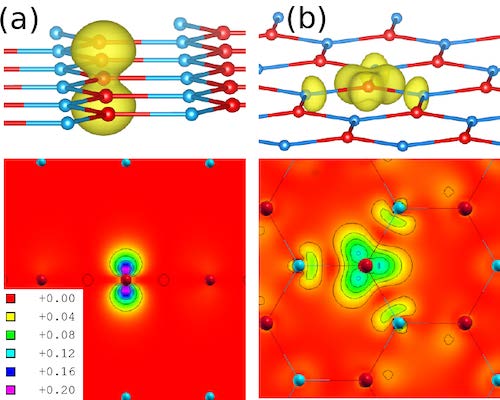Core-valence Bethe Salpeter using plane waves
Core-valence Bethe Salpeter using plane waves
Research questions:
The excitation of core electrons into the conduction band is an important probe to determine the local environment of atoms. To interpret experimental results, theoretical calculations are expedient, and many plane wave codes allow such calculations in the independent particle approximation (IPA). In hierarchical materials involving defects and interfaces, however, excitonic effects mediated by electron-hole attractions can be sizeable, requiring a treatment beyond the IPA. The theoretical framework then is the Bethe Salpeter equation (BSE), first considered in [1] and recently implemented in Wien2k [2].
Electron density of conduction band states for a core hole in boron-nitride corresponding to first (a) and second (b) peak in the boron K edge spectrum.

Electron density of conduction band states for a core hole in boron-nitride
corresponding to first (a) and second
(b) peak in the boron K edge
spectrum.
Methods:
The simplest method to determine core hole spectra is to use large supercells, excite one electron for a chosen atom from the core to the valence shell, perform a single selfconsistent calculation and determine the conduction band spectrum. This approach was recently implemented in VASP and compared to other codes [3] (see figure). The approach is directly applicable to large systems that are required to modell hierarchical materials. However, important many body effects are missing, and to resolve this issue, the student will implement the core-conduction band BSE in VASP [1,2]. This approach accounts for electrostatic electron-hole interactions. Furthermore, the code will be used to study the properties of interfaces and defects in hierarchical materials to precisely determine which defects are present. The project is ideally suited for a PhD student, since it is self-contained, encompasses a foray into modern many body physics, and involves close interaction with the experimental groups.
Time frame:
Months 1-12: Literature survey, study existing valence BSE code; months 12-24: implementation; application to simple materials; months 25-32: first paper, application to hierarchical materials; months 33-48: second and third paper and thesis.
Participating DCAFM-faculty:
Kresse (PI), Pichler (spectroscopy of filled CNT hybrids), Kotakoski (structure and dynamics of defects).
[1] J. Vinson, J. J. Rehr, J. J. Kas and E. L. Shirley, Phys. Rev. B 83, 115106 (2011), DOI: 10.1103/PhysRevB.83.115106.
[2] R. Laskowski, N. E. Christensen, P. Blaha and B. Palanivel, Phys. Rev. B 79, 165209 (2009), DOI: 10.1103/PhysRevB.79.165209.
[3] F. Karsai, M. Humer, E. Flage-Larsen, P. Blaha, and G. Kresse, Phys. Rev. B 98, 235205 (2018), DOI: 10.1103/PhysRevB.98.235205.
